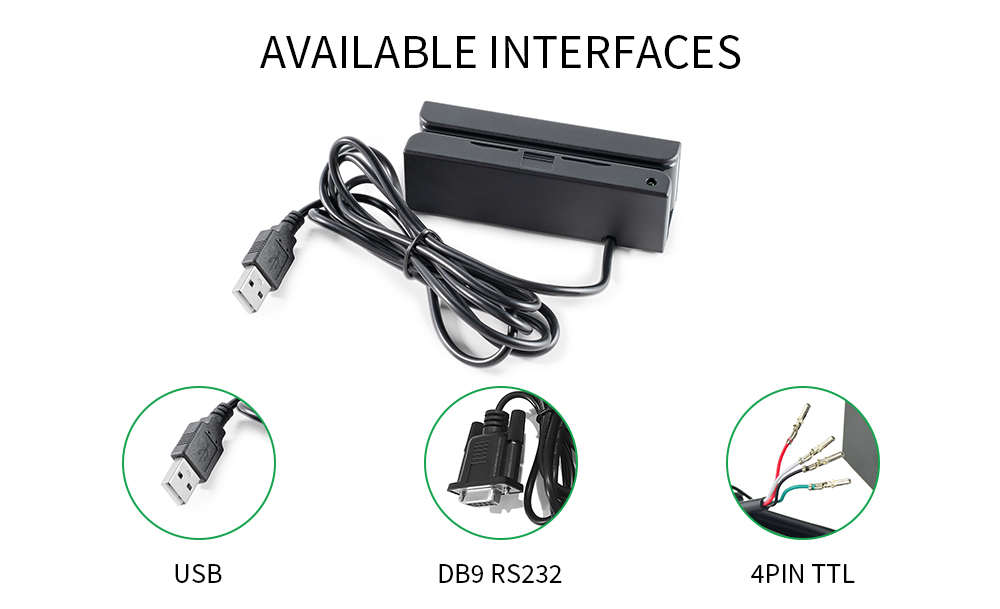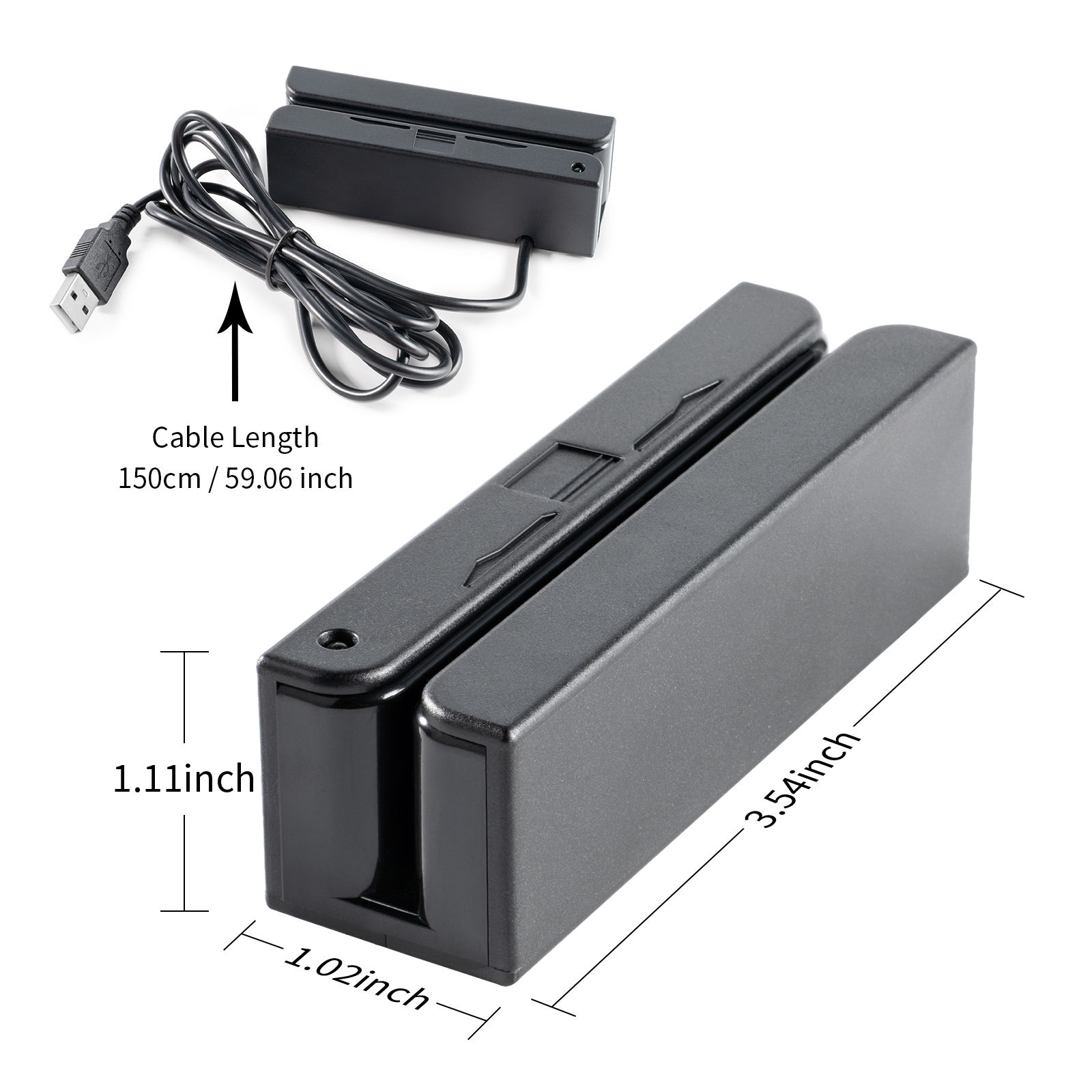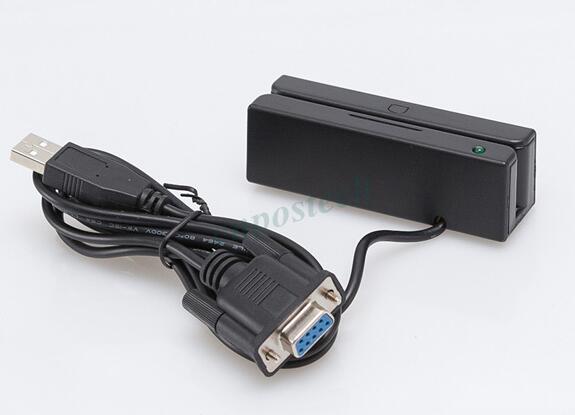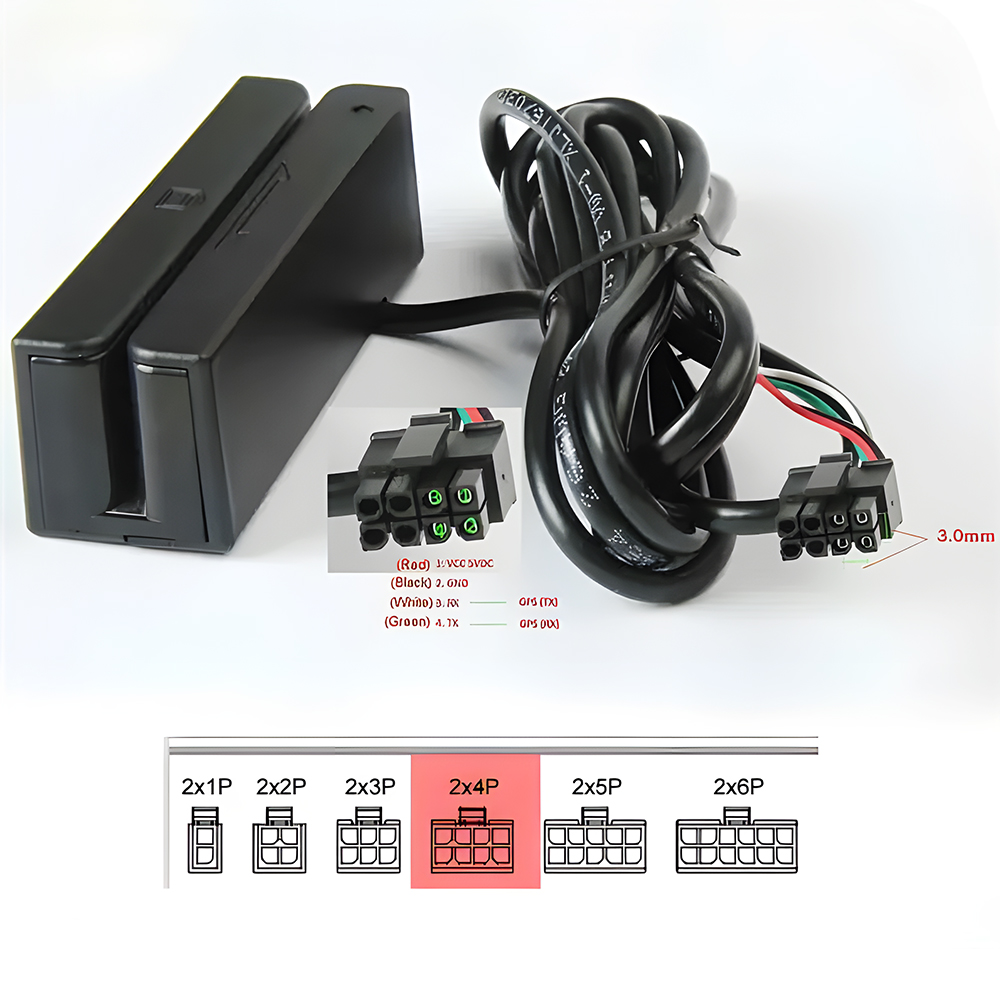
Choosing the right magnetic stripe card reader can be hard. You need to match your device to where you use it. This could be a store checkout or a security system. Voltage levels are important. Device compatibility is also important. Look at how different places affect your choice:
Influence on Interface Selection | |
|---|---|
Point-of-Sale Systems | You need fast transactions and safe payments. |
Access Control Systems | Good integration keeps things safe and blocks unwanted entry. |
Inventory Management Systems | Good tracking helps your business work well. |
Customer Relationship Management | Better customer info means happier customers and smarter ads. |
If you want easy setup and new features, a USB RS232 Magnetic Card Reader can help.
Key Takeaways
Learn about the three main interfaces: USB, RS232, and TTL. USB works best with new devices. RS232 is good for older systems. TTL fits custom projects well.
Pick USB if you want easy setup. USB gives power and data with one cable. This makes it fast to connect and use.
Use RS232 for old machines. It works with legacy systems. RS232 may need extra power. It also sends data slower than USB.
Choose TTL for embedded systems. TTL uses low voltage and is small. It lets you use custom protocols. TTL is great for DIY projects.
Always check if your device matches the interface. Make sure your device supports it before you buy. This helps you avoid problems when setting up.
Interface Comparison
Key Differences
You may ask why TTL, RS232, and USB are not the same. Each one uses a different voltage and needs different power. They also work best in certain places. Here’s a table that shows the main facts:
Interface | Voltage Level | Power Requirements | Typical Applications |
|---|---|---|---|
TTL | 0-3.3V / 5V | Low | Embedded systems, microcontrollers |
RS232 | +/-12V / +/-13V | Moderate | Industrial devices, legacy systems |
USB | 5V | Provides power and data | PCs, POS terminals, modern devices |
TTL readers are good for simple electronics. You find them in small devices and special projects. RS232 readers work with older machines and some factory equipment. USB readers are very common now. You can plug them into computers and POS systems. They send data and get power from one cable.
Tip: USB interfaces are easy to set up. You do not need extra power cords or adapters.
TTL uses less power than RS232. USB gives both power and data, so you do not need more wires. TTL readers cost less and send data fast. RS232 readers are a little slower, but you will not notice most of the time.
Many magnetic stripe card readers, like IntelliStripe 65 and Sidewinder, let you choose your interface. You can use USB RS232, TTL, or switch between them. This helps you match your reader to your system.
Use Cases
Let’s look at where each interface works best. You want to pick the right one for your job.
TTL
TTL is used in embedded systems. If you build your own device or use microcontrollers, TTL is a good choice. It is simple and cheap.RS232
RS232 works with old computers and factory machines. If you need to connect to older equipment, RS232 is best. It is strong and reliable.USB
USB is great for new setups. You plug it into a PC or POS terminal. It is quick and simple. You do not need extra power supplies.
Here is a look at a popular model that supports many interfaces:
Feature | Description |
|---|---|
Model | |
Interface Options | USB HID, USB keyboard emulation, USB OTG, RS232 serial port (customizable) |
Compliance Standards | ISO 7811, ANSI, AAMVA, CA DMV standards |
Swipe Capability | Bidirectional swipe, reads 1, 2, and 3-track magnetic card data |
Applications | POS systems, access control, financial applications |
You see models like MSR100 in stores and offices. They do many jobs and let you pick the interface you want. If you need a reader for new and old systems, a USB RS232 Magnetic Card Reader is a good choice.
1. Understanding Magnetic Stripe Card Reader Interface
When you look at magnetic stripe card readers, you will see USB and RS232 a lot. These two interfaces help you connect your reader to many devices. USB is very popular because it sends power and data with one cable. You do not need extra power adapters. Just plug it into your computer or POS system. Then you can start using it right away. RS232 is also common, especially in older setups or factory machines. It uses a different cable and works well with old equipment.
You might ask why the interface is important. The answer is easy. The interface decides how your card reader talks to your system. If they cannot talk to each other, you will have problems. That is why you should think about protocol and command set compatibility before you buy or install a reader.
Here are some things to check for easy setup:
Make sure your system works with the interface you pick, like RS-232, TTL, or Wiegand.
Some readers can find out what device they are connected to without special setup.
If you use Ethernet, you might need to do extra setup steps.
Some models, like MagTek Single-Track TTL Reader, MagTek Dual-Track TTL Reader, and MagTek RS-232 Reader, work with many systems.
HID ProxPoint Plus and HID EntryProx with keypad are also easy to use with many devices.
If you want a reader that works with both new and old systems, a USB RS232 Magnetic Card Reader is a good choice. It gives you more options and makes setup easier.
Tip: Always read the manual to see which protocols and command sets are supported before you connect your reader. This step saves you time and trouble later.
2. USB Card Reader Interface

Features of USB Readers
You see USB card readers everywhere. They connect fast and work with most computers and POS systems. USB readers use a 5V power supply, so you do not need extra cables. You just plug the reader in, and it starts working. Many USB readers support keyboard emulation, so your computer thinks you are typing the card data. Some models even let you switch between USB and RS232 modes, which gives you more options.
Advantages
USB card readers make your life easier. You get plug and play, so you do not need to install drivers or mess with settings. You can swap devices without turning off your system. USB gives you both power and data in one cable. Here is a quick look at the main advantages:
Advantage | Description |
|---|---|
Plug and Play | You connect and use the reader right away. |
Hot Swap | You can change devices without shutting down your computer. |
Dual Functionality | USB gives you power and data, so you need fewer cables. |
Tip: If you want a simple setup, USB is the way to go. You save time and avoid extra wires.
Limitations
USB readers do have some limits. Not every device supports every USB reader. Some older Android devices may not work with certain USB protocols. You need to check if your device supports the right file system and SD card standard. Budget devices sometimes have slow data transfer. Here is a table that shows common problems:
Compatibility Factor | Description |
|---|---|
Android Version Support | Older Androids may not work with some USB readers. |
Device Hardware and USB-C Implementation | Some USB-C ports do not give enough power or speed. |
SD Card Standards | Your reader must match the SD card type you use. |
File System Support | Your device must support the file system on your SD card. |
Device Support Considerations | Cheap devices may have slow USB speeds or custom ports. |
Typical Applications
You find USB card readers in many places. They work well in retail stores, banks, and offices. You see them at checkout counters and access control points. USB readers are great for POS systems and computers. If you want a reader that works with new and old setups, you might choose a USB RS232 Magnetic Card Reader.
Example Scenario
Let’s look at a real-world example. The IDT3331-12U uses a USB keyboard interface. You see this model in point-of-sale applications. It helps cashiers scan cards quickly and keeps lines moving.
Model | Interface Type | Application Area |
|---|---|---|
IDT3331-12U | USB keyboard interface | Point-of-sale applications |
Note: USB card readers help you work faster and keep your setup simple.
3. RS232 Card Reader Interface

Features of RS232 Readers
RS232 card readers are simple and strong. You connect them with a serial port. This port is found on old computers and machines. RS232 readers use special voltage levels. They often need power from an outside source. Some models are smaller and lighter than others. Many RS232 readers work at 9600 baud. This speed is good for most businesses.
Feature | Description |
|---|---|
Model | Magnetic Stripe Card Reader Writer Encoder MSR605 |
Interface | RS232 |
Communication Standards | Standard RS232 signal voltage levels |
Baud Rate | 9600 Baud |
Power Supply | External switching Power 9V/2A regulated |
Dimensions | Smaller than others |
Weight | 1.4Kg approx |
Advantages
RS232 readers have many good points. They work well in factories and stores. These readers are great for old systems. They can handle lots of use. You can set them up fast. They connect easily to hardware you already have.
Advantage | Description |
|---|---|
Compatibility with legacy systems | RS232 interfaces are often required for older systems, ensuring seamless integration. |
Durability for heavy use | Designed to withstand rigorous use in industrial and POS environments. |
Ease of integration | Simple connection to existing hardware setups, minimizing installation time. |
Tip: RS232 is a good pick for tough places or old machines.
Limitations
RS232 readers have some problems too. You must think about cable length and signal quality. The connectors are big and take up space. Pins can break or bend if not careful. Data moves slower on long cables. This can cause trouble.
You need the right cable for RS232 to work well.
Big DB9 connectors are hard to fit in small spaces.
Pins can get damaged or bent during use.
Limitation | Explanation |
|---|---|
Maximum Cable Length | RS232 is limited by its maximum cable lengths which vary with baud rates. |
Signal Integrity | Maintaining signal integrity is crucial for reliable RS232 communication, especially at higher baud rates and longer cable lengths. |
Unbalanced Transmission | The RS232 interface uses unbalanced transmission, which can be a limitation in certain applications. |
Bulky Connectors | The bulky design of DB9 connectors can pose challenges in tight spaces. |
Exposed Pins | Exposed pins are prone to damage, increasing the risk of broken or bent pins during use. |
Slower Data Transmission | RS232 is associated with slower data transmission speeds over long cables, leading to communication breaks and system issues. |
Typical Applications
You see RS232 readers in many places. They are used in factories and with machines. They help microcontrollers talk to other devices. RS232 is good for data logging and fixing problems. Stores use RS232 for safe data transfer. Factories use it to control machines in real time.
Application Area | Description |
|---|---|
Embedded Systems | Commonly used for microcontroller communication, data logging, and debugging. |
Industrial Settings | Connects PLCs, HMIs, and automation devices for real-time data exchange. |
Industrial Machinery | Ideal for factory floors due to its resilience and ability to connect various devices. |
POS Systems | Frequently utilized in point-of-sale systems for reliable data transfer. |
Automation Controls | Facilitates seamless control of machinery in industrial environments. |
Example Scenario
Think about a busy store using the MSR605 reader. This reader connects with RS232 and runs at 9600 baud. It needs a 9V power supply. The reader is small, so it fits in tight spots. Store workers use it for quick and safe card sales. If you want a reader for both new and old systems, try a USB RS232 Magnetic Card Reader for more options.
4. TTL Card Reader Interface

Features of TTL Readers
TTL card readers are good for embedded systems. You can hook them up to microcontrollers right away. They use low voltage, like 3.3V or 5V. You do not need extra adapters for them. TTL readers are small, so they fit in tight spots. They do not use analog signals, so wiring is simple. Data moves steadily, and you can make your own protocols.
Feature | Advantage |
|---|---|
Direct Connection | |
Stable Transmission | Sends data reliably and reduces errors |
Custom Protocol Support | Lets you debug and use special protocols for your needs |
Low-profile Design | Saves space and fits inside small devices |
No Analog Signals | Makes wiring simple and avoids analog signal problems |
Noise Resistance | Works well even near noisy devices like monitors and power supplies |
Types of TTL
4PIN TTL Interface
8PIN TTL Interface
16PIN TTL Interface
Advantages
TTL card readers have many good points. They save space and keep your device tidy. You do not have to worry about other electronics causing problems. TTL readers help you make custom projects for your needs. You can connect them to smart card readers, GPS, or sensors.
Limitations
TTL readers also have some downsides. You must check the voltage before you connect them. TTL outputs cannot connect straight to CMOS inputs. If you do not check, your device might not work or could break.
TTL outputs cannot drive CMOS inputs because of different voltage and current needs. This can cause your device to work badly or even get damaged.
Typical Applications
TTL card readers are used in many places. They are great for microcontroller projects and small systems. Here are some ways people use them:
Connecting to GPS devices
Used in industrial tools
Used with USB barcode or smart card readers
Example Scenario
You can find TTL card readers in public transport. In Thailand, taxis and buses use magnetic stripe card readers with TTL. These readers help drivers and riders pay fast and track trips.
Tip: If you build your own device or need a reader for a small system, TTL is a smart pick. You get easy wiring, steady data, and a small size.
5. Detailed Comparison: USB vs RS232 vs TTL
You might wonder how USB, RS232, and TTL stack up against each other. Let’s break it down so you can see which one fits your needs best.
Here’s a quick table that shows the main differences:
Interface | Data Transfer Speed | Reliability | Ease of Integration |
|---|---|---|---|
USB | Up to 480 Mbps | High | High (plug-and-play) |
RS232 | Up to 115.2 Kbps | Moderate | Moderate |
TTL | Varies (depends on circuit) | High | High (simple integration) |
If you want fast data, USB wins. You get speeds up to 480 Mbps. That means you can move lots of information quickly. RS232 is much slower. It tops out at 115.2 Kbps. TTL speed depends on your setup, but it usually works well for small projects.
Let’s talk about reliability. USB gives you strong, stable connections. You don’t have to worry about data errors. RS232 can run into problems with noise. If you use long cables or work in a busy factory, you might see data errors. TTL is reliable too, especially in simple circuits.
Ease of integration matters when you set up your system. USB makes things easy. You just plug it in, and it works. Most computers and POS systems support USB. RS232 takes more work. You need the right cable and sometimes extra power. TTL is simple if you build your own device. You connect it straight to your microcontroller.
Here are some quick facts to help you decide:
USB supports different speeds: 1.5 Mbps (low), 12 Mbps (full), and 480 Mbps (high).
RS232 is slower and can get noisy.
TTL is great for custom projects and small devices.
Tip: If you want speed and easy setup, go with USB. If you work with old machines, RS232 might be better. TTL is perfect for DIY and embedded systems.
Now you know how these interfaces compare. You can pick the one that matches your project and environment.
6. How to Choose the Right Interface
Picking the right interface for your magnetic stripe card reader can feel tricky. You want something that fits your setup and works every time. Let’s break it down so you can make a smart choice.
Step-by-Step Checklist
Know Your Device
Check what kind of system you have. Is it a PC, a POS terminal, or an embedded board?Check Compatibility
Look at the ports on your device. Do you see USB, RS232, or TTL pins?Think About Power
Does your reader need extra power? USB gives power and data. RS232 and TTL might need separate power.Consider Speed
Do you need fast data transfer? USB is the fastest. TTL is good for small projects. RS232 works for older machines.Plan for the Future
Will you upgrade your system soon? USB is flexible and works with new tech.
Quick Comparison Table
Situation | Best Interface | Why? |
|---|---|---|
Modern PC or POS | USB | Easy setup, plug and play |
Old factory equipment | RS232 | Reliable for legacy systems |
DIY or embedded project | TTL | Simple, low power, compact |
Tip: If you want less hassle, go with USB. You get power and data in one cable.
Ask Yourself
Do you need to connect to old machines?
Are you building your own device?
Do you want fast and easy setup?
If you answer yes to any of these, you know which interface to pick. USB works for most new systems. RS232 fits older setups. TTL is great for custom builds.
Remember, the right choice saves you time and trouble. Take a moment to match your reader to your system. You’ll thank yourself later!
7. EFFON’s Magnetic Stripe Card Reader Solutions
When you look for a magnetic stripe card reader, you want something that works every time. EFFON’s solutions make your job easier. You get a device that fits your needs, whether you run a store, manage access control, or build your own system.
Why Choose EFFON?
EFFON stands out from other brands. You notice the difference right away. The MSR100 model gives you a compact design, so you can fit it almost anywhere. You do not have to worry about bulky equipment taking up space on your counter or desk.
Let’s see how EFFON compares to other brands:
Feature | EFFON’s MSR100 | Other Brands |
|---|---|---|
Design | Compact design | Often bulkier |
Compatibility | HiCo compatibility | May not support HiCo |
Functionality | USB plug-and-play | May require driver installation |
Track Reading | Reads all three tracks | Some only read two tracks |
Application | Versatile for various uses | Limited application scenarios |
You get HiCo compatibility with EFFON. This means your card reader works with high-coercivity cards, which keep your data safe. Many other brands do not support HiCo, so you miss out on extra security.
EFFON’s USB plug-and-play feature saves you time. You plug in the reader, and it works. You do not need to install drivers or mess with settings. Some other brands make you go through extra steps before you can use their readers.
EFFON’s MSR100 reads all three tracks on a magnetic card. You get more data and more options. Some readers only read two tracks, so you lose important information.
You can use EFFON card readers in many places. They work for retail, banking, access control, and custom projects. Other brands might limit you to just one or two uses.
Tip: If you want a card reader that is easy to set up, secure, and flexible, EFFON gives you everything you need.
Here’s a quick list of what you get with EFFON:
Compact design for easy integration
High-coercivity compatibility for secure data
USB plug-and-play for quick setup
Reads all three tracks for more versatility
EFFON helps you work smarter. You spend less time setting up and more time getting things done. If you want a reliable card reader, EFFON is a smart choice.
8. Future of Card Reader Interfaces
You might wonder what’s next for magnetic stripe card readers. The world keeps changing, and so do the tools you use. New rules and fresh technology shape how card readers work. You see more security features, smarter designs, and even eco-friendly materials. Let’s help you pick the right interface for your future needs.
Checklist
Here’s a simple checklist to guide you when you choose a card reader interface:
Check Security Standards
Make sure your reader meets the latest PCI DSS rules. These standards help protect your data and keep your business safe.Look for Modern Features
See if your reader supports contactless payments or EMV chips. These features offer better security and faster transactions.Think About Sustainability
Choose readers made with eco-friendly materials. Modular designs make repairs easy and reduce waste.Match Your Device
Pick an interface that fits your system. USB works well for new computers. RS232 fits older machines. TTL is great for custom projects.Plan for Upgrades
Ask yourself if you’ll need new features soon. A flexible reader lets you switch interfaces or add new functions.
Tip: If you want to future-proof your setup, look for readers that support multiple interfaces and follow the latest security standards.
Flowchart
You can use this flowchart to decide which interface fits your needs best:
flowchart TD
A[What device do you use?] -->|PC or POS| B[Choose USB]
A -->|Old equipment| C[Choose RS232]
A -->|Custom project| D[Choose TTL]
B --> E{Need contactless or EMV?}
E -->|Yes| F[Pick reader with USB + EMV/contactless]
E -->|No| G[Standard USB reader is fine]
C --> H{Upgrade soon?}
H -->|Yes| I[Pick RS232 + USB combo]
H -->|No| J[RS232 reader is enough]
D --> K{Eco-friendly design needed?}
K -->|Yes| L[Choose modular TTL reader]
K -->|No| M[Standard TTL reader works]
You see how easy it is to match your needs with the right interface. Just follow the steps, and you’ll find the best fit for your business or project. The future brings more choices, so stay ready for new trends and smarter card readers.
You now know how to pick the right card reader interface. Think about your device, speed needs, and where you will use it. Match the interface to your setup for the best results. Use the checklist and flowchart to help you decide. If you want something flexible for both old and new systems, try a USB RS232 Magnetic Card Reader. You will save time and avoid problems.
FAQ
What is the main difference between TTL, RS232, and USB interfaces?
TTL uses low voltage and works best with microcontrollers. RS232 connects to older machines and uses higher voltage. USB is common in modern devices and gives you both power and data with one cable.
Can I use a USB card reader with any computer?
Most computers support USB card readers. You just plug it in and start using it. Some older computers may need drivers. Always check your device’s compatibility before you buy.
Do I need extra power for RS232 or TTL card readers?
RS232 and TTL readers often need a separate power supply. USB readers get power from the USB port, so you do not need extra cables.
Which interface should I pick for a DIY project?
You should pick TTL for DIY or embedded projects. It is simple, uses low power, and connects directly to microcontrollers. TTL readers also save space in your design.

